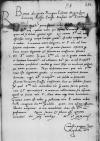Accepimus litteras Paternitatis Vestrae, quibus nobis pro episcopatu Varmiensi, nostra opera ad se delato, gratias agit. Qui animus Paternitatis Vestrae, tam officiosus tamque accepti beneficii gratus, est nobis acceptus ac iucundus. Curavimus autem diligenter, ut Paternitas Vestra ad hunc episcopatum eveheretur, quem illi ex animo favimus cupimusque hanc novam dignitatis et fortunarum accessionem feliciter Vestrae Paternitati evenire. In qua Paternitas Vestra, ut in gratia Domini Dei et hominum benevolentia ad utilitatem ecclesiae suae ac ad rei publicae commodum praesideat multosque annos felix ac incolumis exigat ex animo precamur. Non dubitamus vero, quin Vestra Paternitas novo isto dignitatis gradu et ornamento amplioris fortunae decorata Sigismund I Jagiellon (Zygmunt I) (*1467 – †1548), King of Poland and Grand Duke of Lithuania (1506-1548); Duke of Głogów (Glogau) (1499-1506), Duke of Opava (1501-1506), Governor of Silesia (1504-1506); son of King Kazimierz IV Jagiellon and Elisabeth of Austria⌊regiae maiestatiSigismund I Jagiellon (Zygmunt I) (*1467 – †1548), King of Poland and Grand Duke of Lithuania (1506-1548); Duke of Głogów (Glogau) (1499-1506), Duke of Opava (1501-1506), Governor of Silesia (1504-1506); son of King Kazimierz IV Jagiellon and Elisabeth of Austria⌋ et Poland (Kingdom of Poland, Polonia)⌊rei publicaePoland (Kingdom of Poland, Polonia)⌋, uti fidelis ac primarius Royal Prussia (Prussia Regalis), region, part of Prussia annexed to the Kingdom of Poland in 1466 under the provisions of the Second Peace of Thorn⌊istarum terrarum PrussiaeRoyal Prussia (Prussia Regalis), region, part of Prussia annexed to the Kingdom of Poland in 1466 under the provisions of the Second Peace of Thorn⌋ consiliarius, bene ac fideliter serviet, id quod Paternitas Vestra commodius nunc quam antea facere poterit, cum et opes maiores et maiorem auctoritatem sit consecuta. Quod ut faciat Vestra Paternitas, illam etiam atque etiam hortamur.
Gratum autem est nobis, quod pollicetur Vestra Paternitas mittere nobis velle imaginem serenissimae Isabella Jagiellon (*1519 – †1559), 1539-1559 Queen of Hungary; from 1539 wife of John Zápolya, King of Hungary, mother of John II Sigismund Zápolya; daughter of Sigismund Jagiellon, King of Poland, and Bona Sforza⌊IsabellaeIsabella Jagiellon (*1519 – †1559), 1539-1559 Queen of Hungary; from 1539 wife of John Zápolya, King of Hungary, mother of John II Sigismund Zápolya; daughter of Sigismund Jagiellon, King of Poland, and Bona Sforza⌋, quam, cum ad nos afferetur, libenter accipiemus et cum iucunditate dono isto Paternitatis Vestrae perfruemur.
Quam sanam et felicem esse optamus.


 BCz, 3465, p. 270
BCz, 3465, p. 270